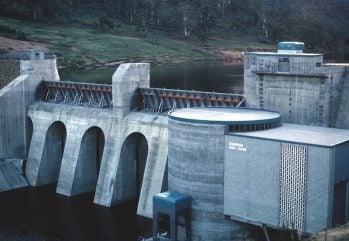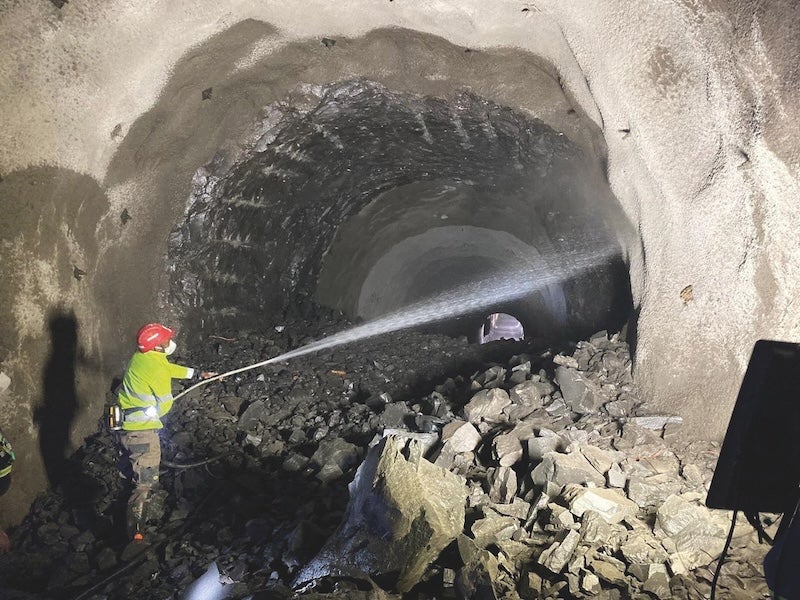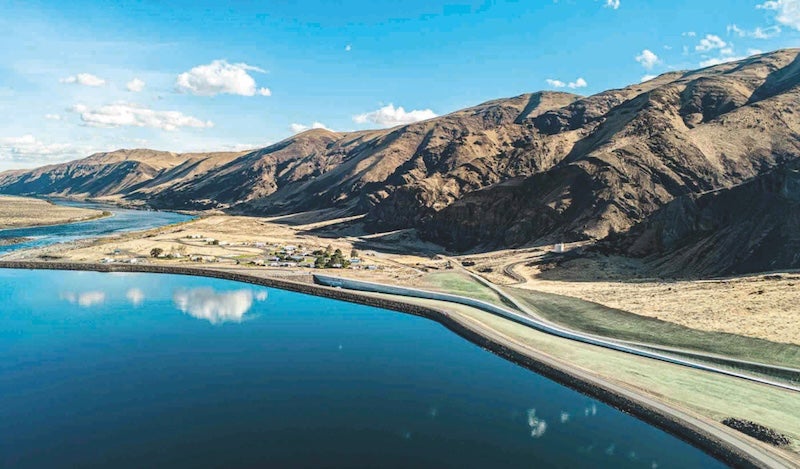
Around the world, ambitious hydropower projects are making significant strides in boosting energy security, improving infrastructure, and adapting to environmental challenges. From the spillway upgrades at Tasmania’s Meadowbank Dam to the tunnelling breakthroughs in Australia’s Snowy 2.0 and Lesotho’s Highlands Water Project, engineers are pushing the boundaries of what these energy systems can achieve. As efforts continue across the US and the UK, these projects are not only securing power for millions but also laying the groundwork for a more resilient, renewable energy future.
In September, Hydro Tasmania announced it has completed a $16million upgrade of the spillway gates at Meadowbank Dam in the Central Highlands.
The newly upgraded crest gates have seen extreme rainfall and have performed well and as expected in these weather conditions. The gates will allow Hydro Tasmania to better manage water levels for lake users and power station operations.
The works were carried out over two summers and Community Engagement Advisor Jane Alpine thanked local residents for their engagement with the project team.
“We are incredibly grateful for the support the community has shown us as we completed this critical work,” said Alpine. “We know how important Lake Meadowbank is to the community. It offers something for everyone, from supporting key agriculture and tourism businesses to providing summer fun for the whole family.”
At Lake Meadowbank, the dam’s spillway is automatically controlled by two crest gates that sit on top of the dam wall. The upgrade replaced the 20 4.2-tonne hydraulic cylinders that keep these hardworking gates moving with new lighter models from Europe.
After consulting with the community, the upgrades were split into two stages to minimise disruption during peak holiday and irrigation periods.
Works were also carried out with the water level as high as safely possible to lessen the impact on lake users.
“Doing the upgrades with the water level higher than usual meant we got a shower or two but we knew it was important for the community to be able to use the lake over summer,” said Hydro Tasmania Project Manager Andrew Rumsby.
As a gesture of thanks to the broader community, Hydro Tasmania contributed to the recently upgraded Dunrobin Park, including the installation of visitor interpretation.
The works are part of Hydro Tasmania’s $1.6 billion program of upgrades to optimise and modernise its hydropower network over the next 10 years.
Tunnelling work
While Tasmania’s Meadowbank Dam upgrades improve local hydropower resilience, Australia’s Snowy 2.0 megaproject takes a bolder step towards national energy security, addressing fresh tunnelling challenges.
A new tunnel boring machine will be deployed to help keep Snowy 2.0 on its delivery timeline, subject to approval by the NSW Department of Planning, Housing and Infrastructure.
New ground testing techniques have provided a better understanding of the full extent of a complex fault zone on the route of the 17km tunnel that will connect Snowy 2.0’s upper reservoir to its underground power station.
Snowy Hydro CEO Dennis Barnes said activating a fourth tunnel boring machine is the right course of action, given that what is now known about the tunnelling challenges ahead has provided the opportunity to mature the design.
“We’ve always known the fault zone was there and I’ve said in the past we will need to take action,” Barnes said. ”While the fault zone is not a surprise, further ground testing since the project reset has revealed it is far more geologically challenging than earlier investigations indicated.
“We’ve carefully considered a range of options to get through the fault zone and overcome the initial design immaturity. Bringing in a fourth machine is the best way to keep the Snowy 2.0 on track for its target completion date of December 2028.”
A modification for Snowy 2.0’s project approval has been submitted to the NSW Department of Planning, Housing and Infrastructure, and will be subject to the Department’s independent community consultation and assessment processes.
The planning modification seeks approval for a change to construction methods within the hydropower project’s already approved work zone. There is no proposal to increase approved land clearing areas, surface or groundwater impacts. Local communities will be consulted about relevant changes to construction methodologies.
“We’re mindful that we are building Snowy 2.0 in a precious and protected national park. We have worked diligently to arrive at a proposal that does not step outside our existing construction area or increase our already approved impacts,” Barnes said.
He said the company remains committed to transparency regarding the project, given the inevitable challenges ahead.
“Just like the construction of the original Snowy Scheme, this is one of the most challenging and complex megaprojects underway in the world,” he said. “The fourth tunnel boring machine is an example of adapting to the situation in front of us, so we are doing everything we can to safely meet Snowy 2.0’s delivery timeline.”
While the need for a new tunnel boring machine is driven by new information about the fault zone, Mr Barnes acknowledged that the disappointing performance of Florence, the tunnel boring machine excavating the same tunnel that the new machine will also work on, has contributed to the need to take significant action.
“It’s difficult to say with certainty whether the same action would be needed if Florence had performed as we had hoped. However, it’s likely that the fourth machine would still be needed,” Barnes said.
Snowy 2.0 pumped storage hydropower project will help underpin Australia’s transition to renewable energy through its ability to generate enough flexible, fast-dispatch energy to power 3 million homes continuously for a week.
The unmatched scale and duration of Snowy 2.0’s storage and generating ability will effectively provide the network with critical electricity supply insurance against extended periods without enough wind and sunlight. Most other forms of storage, including batteries, can only generate power for a handful of hours.
According to AEMO (the Australian Energy Market Operator), Snowy 2.0 will supply a majority of the National Electricity Market’s storage needs, greater than every other storage asset combined.
“Snowy 2.0 is critical to Australia’s energy future. We need to get this job done,” Barnes said.
Subject to planning approval, the new machine will be tunnelling before the end of 2025.
Milestone reached
As Australia tackles these complexities head-on, Africa’s Lesotho Highlands Water Project also reaches a significant tunnelling milestone, pushing forward another phase in its expansive water and power initiative.
On Monday 19 August, the Lesotho Highlands Development Authority (LHDA) celebrated a tunnelling milestone on the Polihali Transfer Tunnel construction site – the successful breakthrough of the upper intake tunnel into the lower intake tunnel after seven months of tunnelling. This is a milestone in the Polihali Transfer Tunnel works and a significant step in the journey towards the impoundment of the Polihali reservoir.
The intake tunnels will allow water from the 5 042-hectare Polihali reservoir to enter the transfer tunnel for delivery to the Katse reservoir, the centre point of the Lesotho Highlands Water Project.
The breakthrough of the intake tunnels is more than just a technical accomplishment; it signifies the start of two critical phases in the project. The first phase involves the safe commencement of impoundment of the Polihali reservoir, made possible by the collapse of the upper tunnel into the lower one. This process allows for a controlled and secure increase in water levels up to the lower tunnel, which can then be temporarily sealed.
The second phase enables continuous debris removal from the remaining tunnel works. As construction progresses towards its connection with the access adit, debris can be efficiently cleared through the upper intake tunnel without interrupting the impoundment process. This efficient operation is crucial for maintaining project momentum while ensuring the structural integrity of the tunnels.
The lower intake tunnel, which plays a vital role in the Polihali Dam’s operational future, will facilitate the intake of live water even at low reservoir levels. This feature is essential for ensuring the uninterrupted flow of water, underscoring the importance of this milestone.
Key milestones in the Polihali Transfer Tunnel works include the excavation of the 450m long tunnel which began on January 16 and was completed on August 19; the completion of the 370-metre long lower intake tunnel on 05 August and the ongoing excavation of the connecting tunnel. The 1322-metre long connecting tunnel will connect the tunnel boring machine (TBM) access adit at the chamber where the TBM will be assembled, marking the start of the TBM-bored transfer tunnel to Katse. To date, 26 metres of the connecting tunnel have been completed.
These achievements are testament to the dedication and expertise of the LHDA and its consultants and contractors: Metsi a Senqu Khubelu Consultants (MSKC), designers of the Polihali Transfer Tunnel and the Kopano Ke Matla Joint Venture, which is constructing the tunnel.
The successful completion of the intake tunnels brings the LHDA one step closer to realising the full potential of the Polihali Dam: increasing the volume of water transferred to South Africa, increasing the volume of hydropower generated in Lesotho, enhancing the livelihoods of Basotho and contributing to the economies of Lesotho and South Africa.
Phase II of the Lesotho Highlands Water Project builds on the successful completion of Phase I in 2003. It delivers water to the Gauteng region of South Africa and utilises the water delivery system to generate hydropower for Lesotho. Phase II will increase the current supply rate of 780 million cubic metres per annum incrementally to more than 1 270 million cubic metres per annum. At the same time, it will increase the quantity of electricity generated in Lesotho and is a further step in the process of securing an independent electricity source to meet Lesotho’s domestic requirements.

Seismic improvements
Across continents, similar efforts are underway at the Priest Rapids Dam in Washington State, where seismic improvements have ensured its readiness for extreme conditions, reinforcing the global focus on dam safety.
Stantec, a global leader in sustainable design and engineering, is proud to announce the successful completion of the Priest Rapids Right Embankment Improvement Project. This critical infrastructure project, undertaken in collaboration with Grant County Public Utility District No. 2 (Grant PUD) and IMCO General Construction, enhances the safety and resilience of the Priest Rapids Dam, which is now able to withstand a 7.1-magnitude earthquake.
Located in Mattawa, Washington, the Priest Rapids Dam plays a crucial role in impounding water for a hydropower powerhouse with a rated capacity of 950MW. Over time, concerns arose regarding the seismic resistance of the dam’s right embankment. To address this issue, Grant PUD initiated the Priest Rapids Right Embankment Improvement Project. Stantec’s team worked diligently to design and construct a downstream replacement dam, with the new structure mitigating potential liquefaction risks associated with the existing dam’s foundation.
Despite the challenges posed by the project’s complexity, the team managed to stay ahead of schedule and the project was completed a month early. The dam was designed and constructed using roller-compacted concrete (RCC), an alternate construction method for concrete dams that offers many advantages. Stantec has prepared designs for more than 25 RCC dams and rehabilitation structures, including gravity, thick-arch, and buttress dams.
“We are thrilled to have successfully completed the Priest Rapids Right Embankment Improvement Project ahead of schedule,” said Mario Finis, executive vice president of Energy & Resources at Stantec. “Our collaboration with Grant PUD exemplifies our commitment to dam safety and community resilience. The project’s success was the result of a strong partnership spanning years of planning and dedication.”
“Completion of the Priest Rapids Right Embankment Improvement Project enhances the protection and preservation of the Wanapum people’s culture who live immediately downstream of the dam,” said Dale Campbell, senior manager of power production at Grant PUD. “This investment in Priest Rapids Dam is strategically critical for our customers as it reduces Grant PUDs public safety and financial risk for the foreseeable future.”

Exploratory work
On the other side of the Atlantic, Scotland’s Coire Glas project continues this global push, with exploratory tunneling paving the way for one of the UK’s most ambitious pumped storage hydropower projects in decades.
Exploratory tunnelling at the site of what would be the UK’s first large-scale pumped storage scheme to be developed in 40 years is now complete. The completion of a 1.2km long exploratory tunnel is the latest milestone in SSE’s ongoing development of its landmark Coire Glas project in the Scottish Highlands.
Located at Loch Lochy in the Great Glen, the proposed Coire Glas project would have an installed capacity of 1300MW and be capable of delivering 30GWh of long duration electricity storage – enough to be able to provide firm, flexible renewable power for three million British homes for up to 24 hours non-stop.
SSE Renewables hopes to make a final investment decision on the project in late 2025 or early 2026, allowing for main construction to commence in the second half of 2026, subject to being successful in the administrative allocation of an investable cap and floor mechanism.
Exploratory works at Coire Glas commenced in December 2022 and are being conducted by STRABAG UK.
In early 2023, SSE announced a £100-million investment boost to further develop Coire Glas to include the construction of a major exploratory tunnel as part of a comprehensive package of site investigation works.
SSE’s technical partners, Stantec and COWI, have designed and supervised the unique and complex ground investigation programme which is being delivered by STRABAG.
The works included the creation of a tunnel approximately five metres high and four and a half metres wide which cuts into the hillside around the proposed location of the underground powerhouse complex. Construction of the tunnel will allow the project team to gather accurate information on the geological conditions to inform the detailed design for the main works.
Now that tunnel construction is complete, a programme of exploratory drilling and testing is continuing to further investigate the ground in the area of the proposed underground powerhouse excavations.
“The works progressed to plan, and samples of the materials excavated from within the hillside are currently being analysed,” Mike Seaton, SSE Renewables Director of Development for Coire Glas, said. “This phase of the project is an engineering challenge in itself and we are learning a huge amount as we progress the works. The findings of the tunnelling works, alongside our wider site ground investigation works completed by Fugro in December 2023, will be used to inform the final design, including the detailed design of underground structures, and will be a key consideration in any final decisions related to the project.”
“The Stantec team has thoroughly enjoyed working on this stage of the Coire Glas project, delivering award winning work alongside COWI, STRABAG, and SSE Renewables,” said John OrdBusiness Director, Energy, Stantec. “We look forward to continuing our support as it moves into the next phase, defining rock quality more than a kilometre inside the mountain. This important work will inform the design of the main pumped storage scheme, moving the project closer to offering a huge boost for the UK’s renewable energy storage.”
“At COWI we’re delighted to have reached the important milestone of the end of the tunnelling phase for the exploratory tunnel,” said Andy Sloan, Managing Director, COWI in the UK. “The joint Stantec/COWI site team have worked tirelessly with SSE Renewables and STRABAG to reach this point and collaboration has been excellent. The Stantec/COWI team will now move on to supervise the underground drilling, which includes complex testing rarely seen in the UK.”






